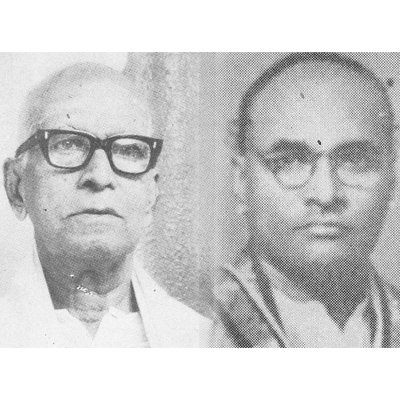
Many pairs of nagaswara vidwans have illuminated the Carnatic music stage for nearly a century. Tiruveezhimizhalai Subramania Pillai, born in 1893, and his younger brother Natarajasundaram Pillai were among the first, if not the very first, to perform nagaswaram duets. They were initially referred to as the Tiruveezhimizhalai Pasanga or Boys, but later came to be known as the Tiruveezhimizhalai Brothers. They and their youngest brother Kalyanasundaram Pillai were sons of nagaswara vidwan Tiruveezhimizhalai Swaminatha Pillai.
Subramaniam started his music learning with the flute, while Natarajasundaram trained initially as a vocalist, but neither could eventually resist the power of the nagaswaram, and carried on the family legacy, to join the foremost exponents of the art in their time. They were known not only for their exquisite raga essays like many nagaswara vidwans of their time, but also for their emphasis on learning the sahitya to perfection and investing their blowing of the instrument with utmost fidelity to lyrics. Kalyanasundaram played a key role in this aspect as a vocal music student of the great Naina Pillai at Kanchipuram, who would pass on the knowledge he gained to his elder siblings. For this discipline, the brothers were indebted to their father’s strict insistence on the primacy of the lyrics.
Nayanam music was traditionally distinguished by a spirit of competition and rivalries between different sets of nagaswaram and tavil vidwans. At the time the Tiruveezhimizhalai Brothers began their career, the Tiruppambaram Brothers Natarajasundaram Pillai and Sivasubramania Pillai dominated the scene, with their impressive repertoire, rich in the Dikshitar Sampradaya, along with violin maestro Tirukkodikaval Krishna Iyer, as disciples of Sathanur Panchanada Iyer. The rivalry between the two sets of brothers, both proficient in raga delineation and kriti-rendering, resulted in several great concerts by each. Each pair specialised in achieving such harmony that the music that resulted could easily be mistaken as coming from a single nagaswaram.
True to the family tradition, the Tiruveezhimizhalai Brothers were masters of creative improvisation in all the forms of nagaswaram music—raga alapana, pallavi, rakti, mallari and other ritual music. They also gained mastery over laya by joining the gurukulam of Konerirajapuram Vaidyanatha Iyer, reputed for his rhythmic excellence.
A brother in spirit that the Brothers acquired was tavil maestro Needamangalam Meenakshisundaram Pillai. They were so distraught when he left them to become an independent percussionist that they stopped playing such songs as Tyagaraja’s Chetulara sringaramu whose lyrics could virtually be heard on his tavil.
The brothers not only often excelled themselves in the company of such tavil wizards as Ammapettai Pakkiria Pillai and Vazhuvoor Panchapakesa Pillai, but also earned the respect of eminent musicians like Semmangudi Srinivasa Iyer, Mudicondan Venkatarama Iyer, Kanchipuram Naina Pillai, Fiddle Govindaswami Pillai, and Konnakol Pakkiria Pillai. Yet they had the humility to claim that they could never equal the kalpanaswara excellence of their senior Chidambaram Vaidyanatha Pillai or his mastery of rakti ragas like Huseni.
Devout worshippers of saint composer Tyagaraja, the Brothers were secretaries of the Aradhana Committee of Tiruvaiyaru at the annual festival there.
Subramania Pillai was the first nagaswara vidwan to be decorated by the Madras Music Academy as Sangita Kalanidhi, and honoured by the Indian Fine Arts Association as Rasika Sikhamani. He demonstrated a 64-kalai pallavi before the experts committee in the year of his award. The brothers, who lived into their nineties, developed many disciples into first rate nagaswara vidwans. Among them were Govindaraja Pillai and Dakshinamurthi Pillai, both sons of Subramania Pillai.


